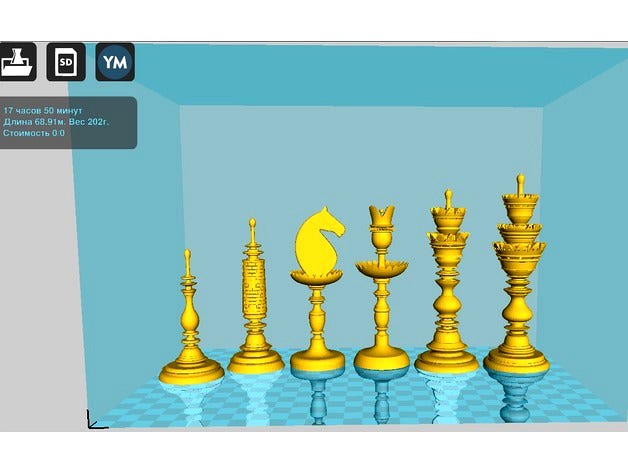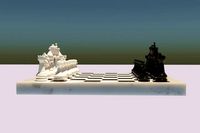Thingiverse

Chess Gustavus Selenus by Tot_By
by Thingiverse
Last crawled date: 2 years, 12 months ago
The model can be reduced to the desired scale of the map of Gustavus Selenus. In the autumn of 1598, the youngest son of the Duke of Brunswick-Lüneburg August continued its two-year tour of Italy. He kept a diary, and among the many impressions of the beautiful cities of Italy a special place is Venice, which he visited three times. It is here that the noble traveler bought "a book about the ingenuity and art of chess" — an Italian translation of the famous work of the Spaniard RUY Lopez.
Having carefully considered his purchase, August decided to create a book about chess for his countrymen. Dream came true: in 1616 in Leipzig published the book "Chess or the Royal game". A major part of it is the translation of the work of Lopez, but there's also information about the history and status of chess in Europe (first mentioned in the chess village Streak) and even — in the distant Muscovy: "the Russians, or Muscovites, playing chess is very witty and with special diligence; in this game they are so skilled and experienced that, in my opinion, other people a hard time with them to compete" (Paul Dearborn, 1581).
Originating during the late Gothic and the emergence of the Baroque, the pieces absorbed the peculiar Gothic style aspiration, underlined openwork ornamentation, and dynamics, the combination of reality and illusion, the fluidity of complex curvilinear forms characteristic of the Baroque. "The upper part of the figures is crowned with the symbolic skeleton, in a way that the Almighty death is laughing at chess game" — contemporaries described chess Selenus. This is a favorite subject of the middle ages: on the Board, kings and pawns, and before death all are equal!
"Selenus" cut from wood and bone, was cast from silver and gold, and the famous Venetian virtuosos even blown wine glasses from glass. Over the years, the shape of the figures underwent little change. So, in the XVIII century delicate rosettes sometimes grind heavier — with this option the Germans called the "crow's nest"...
Having carefully considered his purchase, August decided to create a book about chess for his countrymen. Dream came true: in 1616 in Leipzig published the book "Chess or the Royal game". A major part of it is the translation of the work of Lopez, but there's also information about the history and status of chess in Europe (first mentioned in the chess village Streak) and even — in the distant Muscovy: "the Russians, or Muscovites, playing chess is very witty and with special diligence; in this game they are so skilled and experienced that, in my opinion, other people a hard time with them to compete" (Paul Dearborn, 1581).
Originating during the late Gothic and the emergence of the Baroque, the pieces absorbed the peculiar Gothic style aspiration, underlined openwork ornamentation, and dynamics, the combination of reality and illusion, the fluidity of complex curvilinear forms characteristic of the Baroque. "The upper part of the figures is crowned with the symbolic skeleton, in a way that the Almighty death is laughing at chess game" — contemporaries described chess Selenus. This is a favorite subject of the middle ages: on the Board, kings and pawns, and before death all are equal!
"Selenus" cut from wood and bone, was cast from silver and gold, and the famous Venetian virtuosos even blown wine glasses from glass. Over the years, the shape of the figures underwent little change. So, in the XVIII century delicate rosettes sometimes grind heavier — with this option the Germans called the "crow's nest"...
Similar models
3dwarehouse
free

Türkiye - Kütahya - Şair Şeyhi (Hekim Sinan) Türbesi
... city who is the great poet and science scientist of turkish history. #hekim #kütahya #sinan #turkey #türbe #türkiye #şair #şeyhi
thingiverse
free

Gustavus, Wanna be Warrior by Jeremy8077
...y. also, he's standing on a dungeon tile designed by the one and only dutchmogul http://www.thingiverse.com/dutchmogul/about.
3d_sky
$8

Selenus in Design 3D Board
...n chess by gustav selenusa "chess, or royal price." under the pseudonym "selenusa" was the younger son of ger
3d_sky
free

Photo of children in retro style of Kim Anderson
...sters and prints, made his work known to the whole world. his photographs are recognizable and unique. anyone, even the untrained
thingiverse
free

Death star coffee stencil by Lightshow74
... for a death star stencil so he could style fluffies he was making for his daughter. it also works for coffee i've been told.
cg_trader
$10

Hebe Statue
...goddess of youth, and each time with some variation. the last one, of which this is a model, is in the museum of forlģ, in italy.
3dwarehouse
free

Thomas Tew flag
...5) he had managed to amass a wealth of about £8,000 ($1,651,137.49 today) by the time he died in 1695. #flag #pirate #tew #thomas
thingiverse
free

Mini He-Man - Masters of the Universe (no sword) by cicciom
... by wekster.
wekster did an excellent job on all his mini figures
heman master of the universe is the famous cartoon from the 80s
thingiverse
free

Aspect of Father Basilisk by dutchmogul
...ng strong for about four years now). i'm sure this guy could be useful for representing any number of game characters. enjoy!
thingiverse
free

Thane Erik III the Red DnD #pocket-dungeons #pocket-tactics #multiverse Pathfinder D&D by chdd
...-of-time deals with the civilized "kingdoms"... and how quickly he can re-stain his beard in the blood of the vanished!
Selenus
3d_sky
$8

Selenus in Design 3D Board
...n chess by gustav selenusa "chess, or royal price." under the pseudonym "selenusa" was the younger son of ger
thingiverse
free

Selenus Style Chess Set by Anubis_
...orses; and rooks became civic towers instead of battlements. in england they were frequently called "tulip chess sets".
Gustavus
thingiverse
free

Gustavus, Wanna be Warrior by Jeremy8077
...y. also, he's standing on a dungeon tile designed by the one and only dutchmogul http://www.thingiverse.com/dutchmogul/about.
thingiverse
free

Selenus Style Chess Set by Anubis_
...typical of germany and northern europe and named after gustavus selenus, the pen name of augustus the younger, duke...
3dwarehouse
free

gustavus 3.20
...gustavus 3.20
3dwarehouse
3dwarehouse
free

Gustavus Alaska Retirement Cabin
...gustavus alaska retirement cabin
3dwarehouse
3dwarehouse
free

Gustavus Alaska Retirement Cabin
...gustavus alaska retirement cabin
3dwarehouse
my sister asked for ideas on her retirement cabin of about 1200 ft sq . design #1
3dwarehouse
free

Gustaf Adolfs Torg
...sqaure in gothenburg with a statue of the founder, gustavus adolphus ii. the statue was placed on the square...
3dwarehouse
free

Gustavianum, Uppsala
...now mostly functions as a museum. named after king gustavus adolphus, the building was built from 1622-1625 and houses...
3dwarehouse
free

Holst's house, Barnes
...1913, the residence of british composer gustav holst. born gustavus von holst, of swedish and latvian extraction, he is...
3dwarehouse
free

The English Church, Embassy District, Stockholm, Sweden
...stockholm, sweden 3dwarehouse engelska kyrkan ritades ursprungligen av arkitekt gustavus w. hamilton i liverpool. byggnadsarbetet påbörjades 1863, men grunden...
Tot
turbosquid
$20

Small Car Chassis Tot Rod
...yalty free 3d model mini car chassis tot rod for download as on turbosquid: 3d models for games, architecture, videos. (1376169)
3d_export
$8

tot bottle brush 01
...& .obj. please rate, when you buy. thanks! :) also, please check out my other useful portfolio items that you may be missing!
turbosquid
$20

2CV inspired tot rod car bodyshell lazer cut plywood
...red tot rod car lazer cut plywood for download as dxf and stl on turbosquid: 3d models for games, architecture, videos. (1381486)
3d_export
$49

Human Baby Head 3D Model
...human baby head 3d model 3dexport cute baby infant tot toddler kid child human white caucasian topology uv head...
3ddd
$1

Nomades Authentic Ceilin Lights
...- an electrification kit khaki, black or transparent, according tot the models - the heights are adaptable and the...
3d_ocean
$35

Fantasy House - Fairytale Cottage
...polys - terrain: 4300 polys - grass: 61248 polys tot.. ...
3d_ocean
$6

Willow (Salix) Trees 3d Models
...79 in (200 cm) high; total polygons: 91 318; tot.. ...
3d_ocean
$6

Willow (Salix) Trees 3d Models
...59 in (150 cm) high; total polygons: 58 456; tot.. ...
3d_ocean
$5

Willow (Salix) Trees 3d Models
...39 in (100 cm) high; total polygons: 21 761; tot.. ...
3d_export
$5

Ceiling lamp Viabizzuno Royal Chandelier
...power consumption is only 150 w. led 2700k 60x2.5w (tot150) 24 vdc...
Chess
3ddd
free

Chess
...chess
3ddd
chess , шахматы
chess
3d_ocean
$6

chess
...chess
3docean
chess game
chess,game
3d_export
$5

chess
...chess
3dexport
chess
3d_export
$5

chess
...chess
3dexport
chess
3d_ocean
$6

Chess
...chess
3docean
chess decor design elements game interior
just chess
3d_export
$5

chess
...chess
3dexport
chess modern
3d_export
$5

the chess
...the chess
3dexport
the chess board.
3d_export
free

chess
...chess
3dexport
3d model chess
3d_export
$15

chess
...chess
3dexport
chess complete set with 32 pieces and a board
3d_export
$5

chess
...chess
3dexport
marble chess with ceramic figures, great for interior decoration
